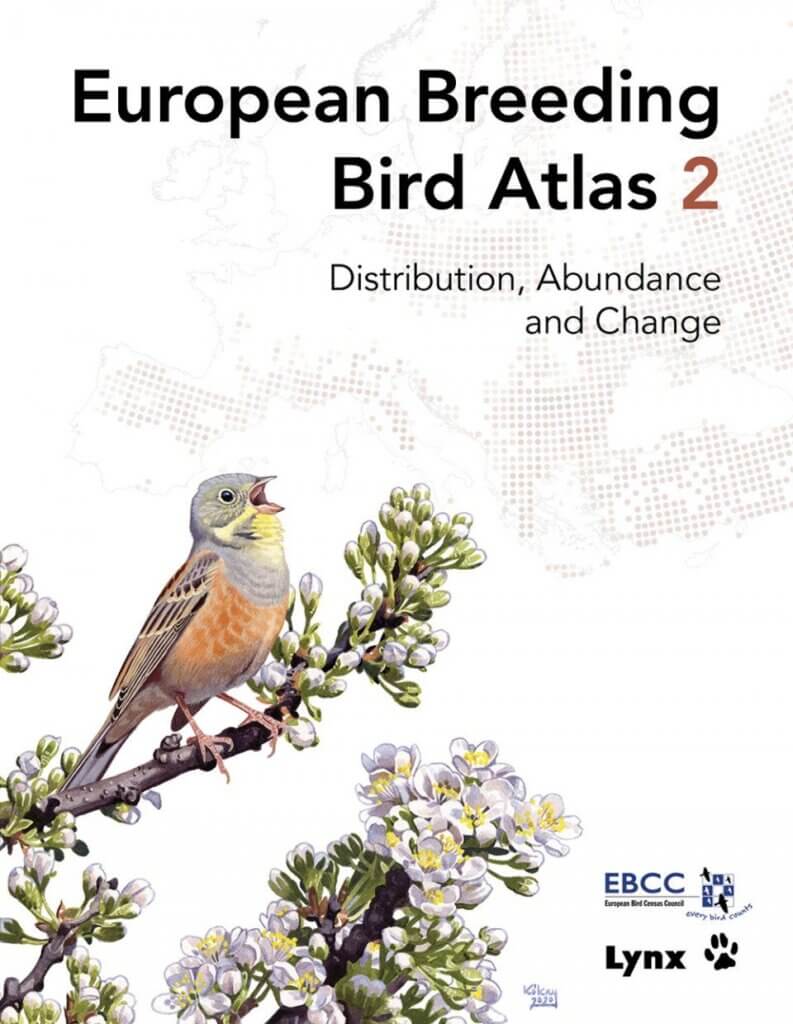
This review is by Roderick Leslie
Weighing in at over 5 kilos EBBA2 is stupendous at every level, a spectacular achievement ranging from a continental overview of a crucial element of our environment to the best guide to where to find breeding birds. The big change since EBBA1, published in 1997, is the near complete coverage of Eastern Europe and European Russia, and the inclusion of Turkey. EBBA2’s continent extends to the Urals and the western shores of the Caspian, Europe’s Mediterranean shores in the south and to the arctic archipelagos and Iceland, but not Greenland. It includes 596 breeding bird species and 556 full species accounts. Most have density and/or level of breeding proof maps and a change between EBBAs 1 and 2. Many also include a sophisticated new model map aimed at showing the probability of occurrence.
I found the density maps, in shades of brown, hard to read. In contrast, in primary red and blue, the change maps although at smaller scale work well.
At the continental level, two big findings jumped out at me. Firstly, the big increase in species counts for the Arctic (+29), Alpine (+23) and Boreal (+9) zones with a small decrease for the Mediterranean (-3), surely strong evidence of the changing climate. Secondly, the stark contrast between birds listed in European Directives, which are doing well, and the broader list of Species of European Conservation Concern, which are doing almost equally badly. It seems to be a continent-wide confirmation of the UK situation where species that have received special attention are generally doing well, whilst widespread species, other than generalists, continue to decline.
Zooming in on species accounts, it’s fascinating to see what’s happening in the bits one knows – and to check one’s own experience against what the 50km square scale maps show. It is equally engrossing to see what is happening across the range of familiar and not so familiar species – and in my case to start to get my head round the huge changes in taxonomic order of the last few years, and even some new splitting and lumping; just one redpoll but several chiffchaffs and a confusion of grey shrikes. For UK listers the top right hand corner brings in the breeding range of a surprising number of sought after Siberian vagrants. And at the very most practical level, I’m already scanning the maps for missing species – I really must see Middle Spotted Woodpecker as soon as we are freed!
At the price of a single on Eurotunnel (£84.99 + p&p) this is a must-have for any continental birder, even if you may need to buy Range Rover to cart it about!
European Breeding Bird Atlas 2: distribution, abundance and change by Verena Keller, Sergi Herrando, Petr Voříšek, Martí Franch, Marina Kipson, Pietro Milanesi, David Martí, Marc Anton, Alena Klvaňová, Mikhail V. Kalyakin, Hans-Günther Bauer and Ruud P.B. Foppen is published as a partnership between the European Bird Census Council (EBCC) and Lynx Edicions
[registration_form]
It is a fantastic achievement just to be able to map the distribution of all those species across such an enormous chunk of the globe. It is disheartening but not really surprising to know that the trends we see in the UK are also apparent across much of Europe (there have been previous reports from other European countries that have told us as much).
I love my EBBA2… I haven’t had time to study it in fine detail yet, I dont understand how the probability maps were made, but I love them. Not very keen on some of the artwork, but thats minor. My colour-blind other half doesnt like some of the colour choices for maps…..but its my book not his book….
We did survey fieldwork in NW Spain specifically for the atlas, so its lovely to check various species distribution/change there, and in the parts of the UK I like, compare with the rest of Europe.
I had to wait far too long for my copy to be shipped (and it had to have a small fee added because it was so popular the second print run of pre-orders wasn’t shipped till after brexit!!). I dont like that it could well be the last ever major paper book atlas of its scale…….whilst being able to look up the maps on a screen in any future hypothetical publication, there is something comfortingly lovely about the real book, and I dont like the taxon order.. they have chosen Handbook of birds of the world order rather than IOC which is itself the confusing new order we are just getting used to in the uK – surely the IOC version should have been the one to pick?
But there are so many reasons to dip into this, because we are, bird-wise, part of Europe, an avifauna that reaches from Iceland and the Azores over to the Urals, and there is so much to learn form distributions and especially the change maps….they are a little cramped, yet tell us so much about population changes